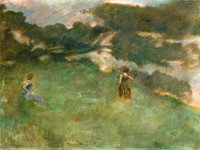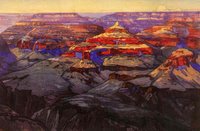poetry & haiku
Labels: ezra pound, imagist poetry

 i guess we haven't yet mentioned many of the other names or styles that are japonisme, in one way or another, in disguise. Of course art nouveau, but also jugendstil, liberty style, arts and crafts, and many more.
i guess we haven't yet mentioned many of the other names or styles that are japonisme, in one way or another, in disguise. Of course art nouveau, but also jugendstil, liberty style, arts and crafts, and many more.Labels: newcomb

Labels: combs
 at a most basic level what i have learned are the keystones that marked japonisme were these: blocks of flat color, blocks of intricate pattern (cloth, wallpaper), asymmetrical layout, an unusual framing, and a stronger than previously seen in the countries where it occurred: an emphasis on nature and daily, domestic life. these were the features in the japanese prints that most notably were adapted by the new art, l'art nouveau.
at a most basic level what i have learned are the keystones that marked japonisme were these: blocks of flat color, blocks of intricate pattern (cloth, wallpaper), asymmetrical layout, an unusual framing, and a stronger than previously seen in the countries where it occurred: an emphasis on nature and daily, domestic life. these were the features in the japanese prints that most notably were adapted by the new art, l'art nouveau.
Labels: asymmetry, thomas dewing, toulouse-lautrec
 and one last binding, for the moment anyway (there are some exquisite covers for some lafcadio hearn books i have to dig up from my files somewhere....), from another stunning collection here.
and one last binding, for the moment anyway (there are some exquisite covers for some lafcadio hearn books i have to dig up from my files somewhere....), from another stunning collection here.Labels: bindings, bookbinding
 not that paris, that art nouveau alone, were influenced by the influx of japanese goods. many artists developed signatures or marks to mimic those used by the japanese. toulouse-lautrec's is famous (click for the exhibition):
not that paris, that art nouveau alone, were influenced by the influx of japanese goods. many artists developed signatures or marks to mimic those used by the japanese. toulouse-lautrec's is famous (click for the exhibition): 
Labels: wiener werkstatte
 i was thrilled to find an online bookseller with an entire section devoted to japonisme! handsome books, and the descriptions of the books, the authors, the designers and illustrators, and of japonisme itself, are priceless.
i was thrilled to find an online bookseller with an entire section devoted to japonisme! handsome books, and the descriptions of the books, the authors, the designers and illustrators, and of japonisme itself, are priceless.

Labels: c yarnall abbott, sanchi ogawa, sarah wyman whitman
 there were western influences on the japanese during this period as well. leaving aside for the moment all of these but those of some printmakers, i would like to point to two: hiroshi yoshida and yumeji takehisa .
there were western influences on the japanese during this period as well. leaving aside for the moment all of these but those of some printmakers, i would like to point to two: hiroshi yoshida and yumeji takehisa .
Labels: hiroshi yoshida, takehisa yumiji
 for the last several days i have been scouring the internet for resources and find there's little agreement to anything (not that this should come as a surprise), mainly, the definitions, but also the history behind it, the range of its influence, etc. so today i will do my best to lay out what i have learned japonisme to be, and will return often, i'm sure, to correct, amend, edit and embellish, etc., and with your help perhaps arrive at something definitive.
for the last several days i have been scouring the internet for resources and find there's little agreement to anything (not that this should come as a surprise), mainly, the definitions, but also the history behind it, the range of its influence, etc. so today i will do my best to lay out what i have learned japonisme to be, and will return often, i'm sure, to correct, amend, edit and embellish, etc., and with your help perhaps arrive at something definitive. also coming from china was an ethic that some say was the breeding ground for buddhism itself: ancient chinese nature- worshipping religions. this, along with a developed buddhism as well switched the human/nature/deity paradigm that had developed in the west on its ear. very quickly nature went from what humans controlled to what humans were.
also coming from china was an ethic that some say was the breeding ground for buddhism itself: ancient chinese nature- worshipping religions. this, along with a developed buddhism as well switched the human/nature/deity paradigm that had developed in the west on its ear. very quickly nature went from what humans controlled to what humans were.Labels: e. gaillard